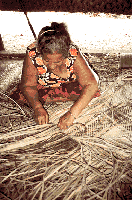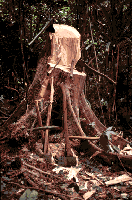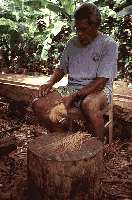
Canoe Materials

 The canoes of
Kapingamarangi were made from materials that could be found on
their atoll. Occasionally this supply was augmented by drift logs.
These drift logs were often preferred due to their seasoned state.
The wood of choice found on the atoll was breadfruit. It should
be noted that this is a different type of tree than the breadfruit
found on Pohnpei. The breadfruit of Kapingamarangi has a different
leaf shape, the fruit has seeds and the wood is thought to be
of superior quality.
The canoes of
Kapingamarangi were made from materials that could be found on
their atoll. Occasionally this supply was augmented by drift logs.
These drift logs were often preferred due to their seasoned state.
The wood of choice found on the atoll was breadfruit. It should
be noted that this is a different type of tree than the breadfruit
found on Pohnpei. The breadfruit of Kapingamarangi has a different
leaf shape, the fruit has seeds and the wood is thought to be
of superior quality.
Other wood used in the construction was from the ivory nut palm. The trunk of this tree is soft in the center and very hard and sinewy along the outer ring. The wood, though small in cross section, is quite strong and used where minimum size and maximum strength is important (i.e., the platform (hata) and the float stansions (hatoto).)

The canoes were
held together by a line made of coconut husks (see Appendix
C). The coconut husk was also used as a caulking material
or gasket between the main hull (waka) and the washboards
(momo). Patching holes and imperfections was accomplished
by using reduced breadfruit sap. For the larger imperfections
a dutchman was used. Paint was originally made by mixing water
with lime obtained from the burning of coral and shells.
The sail material was woven from the sun-dried leaves of pandanas woven into panels. These panels were then stitched together to form the sails. Pandanas as a sail material was eventually replaced by cotton sometime in the early 20th century.